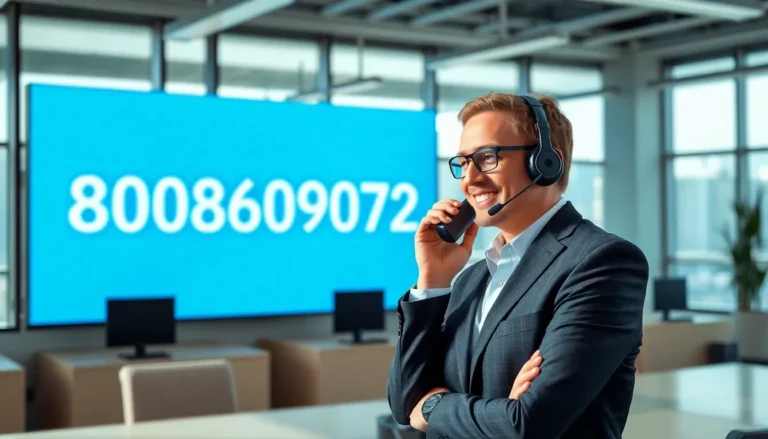Table of Contents
ToggleIn the ever-evolving world of workplace fashion, the question of whether jeans can make the cut for business casual is like asking if pineapple belongs on pizza—everyone has an opinion. Picture this: you stroll into the office, rocking your favorite pair of jeans, and suddenly, you’re the trendsetter of the boardroom. But is it really that simple?
Understanding Business Casual Attire
Business casual attire blends professionalism with comfort. It’s essential to grasp its nuances for appropriate workplace attire decisions.
Definition of Business Casual
Business casual refers to a dress code that combines formal elements with a relaxed style. Typically, it includes dress shirts or blouses without a tie, tailored pants or chinos, and closed-toe shoes. Acceptable options often involve skirts or blazers as well. The goal lies in striking a balance between casual and formal, allowing flexibility while maintaining a professional appearance.
Variations of Business Casual
Variations of business casual exist across industries and regions. In some offices, dark jeans paired with a blazer qualify as acceptable. Others prefer dress pants and dress shoes without any jeans. Creative industries might encourage more relaxed attire, while corporate environments stick closely to traditional standards. Understanding the company culture is crucial for adapting to specific variations, ensuring individuals project the right image consistent with workplace expectations.
The Role of Jeans in Business Casual

Jeans can play a part in business casual attire, depending on workplace standards. Many contemporary offices recognize that jeans, when styled appropriately, offer a comfortable yet professional option.
Types of Jeans Suitable for Business Casual
Dark wash jeans represent a popular choice, as they convey sophistication. Straight-leg and tailored options often appear more polished than distressed or baggy styles. Bootcut jeans can also fit into the business casual realm when paired with the right top. Additionally, jeans without embellishments or excessive fading maintain a clean look, ensuring they align with professional standards.
Colors and Fits to Consider
Colors matter significantly in business casual environments. Navy, charcoal, and black jeans typically work well because they are versatile and maintain a professional tone. Fits should vary based on personal comfort levels; however, tailored or slim fits often project a more refined image. Avoid overly tight or loose options, as they can detract from professionalism. Focusing on these elements helps ensure jeans complement the intended business casual look.
Styling Jeans for a Business Casual Look
Wearing jeans in a business casual setting requires thoughtful styling. Selecting the right pieces enhances the overall appearance, creating a professional yet relaxed vibe.
Pairing Jeans with Appropriate Tops
Incorporating blazers and dress shirts elevates a jeans outfit. Button-down shirts in solid colors or subtle patterns bring sophistication. Opting for tailored tops adds structure, while lightweight sweaters provide comfort without sacrificing style. Avoid casual tees or overly relaxed styles; they don’t fit the business casual standard. Layering with a blazer not only adds polish but also bridges the gap between casual and formal wear. Targeting neutral shades, such as white, black, or navy ensures versatility. These combinations not only look professional but also maintain a sense of individual style.
Choosing the Right Footwear
Footwear selection plays a vital role in achieving a business casual look. Investing in loafers or oxfords conveys professionalism and complements the refined appearance of jeans. While ankle boots can add flair, they should remain classic and polished. Sneakers, though comfortable, typically lack the professional edge necessary for many office environments. Prioritize clean and simple designs while avoiding flashy styles. In terms of color, stick to neutrals or earthy tones that match the overall outfit. This attention to footwear aligns with the desired image, maintaining a balance between casual and professional.
Situations for Wearing Jeans in a Business Casual Setting
Jeans can fit into various business casual scenarios, depending on the context and setting.
Office Environments
Many contemporary office environments embrace jeans as a suitable option. Companies with a relaxed culture often allow dark wash jeans, especially when paired with blazers or tailored shirts. Employees in creative industries frequently find jeans acceptable, offering a balance between professionalism and comfort. Individuals working in tech sectors also see jeans as a standard attire, given the industry’s emphasis on a laid-back approach. Establishing the right fit and style plays a crucial role; tailored and straight-leg options often present a polished appearance.
Company Events and Meetings
Company events and meetings offer another opportunity for wearing jeans in a business casual setting. Networking events typically see attendees in smart casual outfits, allowing for dark jeans combined with dress shoes. When attending work-related gatherings, a blazer can elevate the ensemble, showcasing professionalism while ensuring comfort. Team-building activities might also present a chance to wear jeans, particularly if the event encourages casual attire. Maintaining a well-fitted appearance remains essential, ensuring that resumes confidence and style at professional engagements.
Wearing jeans in a business casual setting can be a stylish and comfortable choice when done right. By selecting the appropriate fit and color and pairing them with polished tops and footwear, individuals can navigate the fine line between casual and professional. Understanding company culture plays a vital role in determining whether jeans are acceptable in the workplace. With the right styling and attention to detail, jeans can indeed become a staple in a business casual wardrobe, allowing for personal expression while maintaining professionalism. Embracing this trend can help individuals stand out while fitting seamlessly into their work environment.






